Equity & Diversity Annual Report – 2003 3. Workplace Diversity Plan
The RBA announced its formal commitment to equal employment opportunity in May 1984 and since then has implemented and reported on six plans to progressively achieve the objectives of its equity and diversity program. The program is intended to encourage good personnel management practices in relation to all staff, while meeting legal obligations for the groups specifically designated under EEO legislation. The plan adopted in 2000/01 recognised the diversity of the staff and sought to accommodate that diversity within broader policies relating to recruitment and selection, staff training and development and conditions of employment.
The development of the latest plan involved assessing the Bank's policies and performance against the requirements of the Equal Employment Opportunity (Commonwealth Authorities) Act 1987, as well as principles endorsed in the Public Service Act 1999, the Equal Opportunity for Women in the Workplace Act 1999 and the Human Rights & Equal Opportunity Commission's Best Practice Guidelines. Accordingly, the Workplace Diversity Plan 2001–2005, places greater emphasis on diversity management reflecting changing trends and new legislative directions.
The areas for action identified in the new Plan include – Gender; Work Life Balance; Indigenous Australians; Race-Ethnicity; and People with Disabilities. As part of the first-stage of the plan a comprehensive workplace profile covering designated groups, age and gender, pay equity and salary packaging, residential location, qualifications, and management composition was prepared. Australian Bureau of Statistics (ABS) data released for Census 2001 also provided a useful basis for comparison against the RBA's workplace demographics. The profile provides a basis for analysing the effectiveness of the Plan and identifying further initiatives.

Workplace Profiles
The decline in staff numbers evident over many years has come to an end. Women now make up only 41% of total Bank staff, compared to 48% in 1993. This downward trend in the representation of women is a result, for the most part, of the decline in the number of clerical positions within the RBA, which has more than halved since 1998. Further analysis of the decline in the representation of women will be undertaken in the next reporting period.
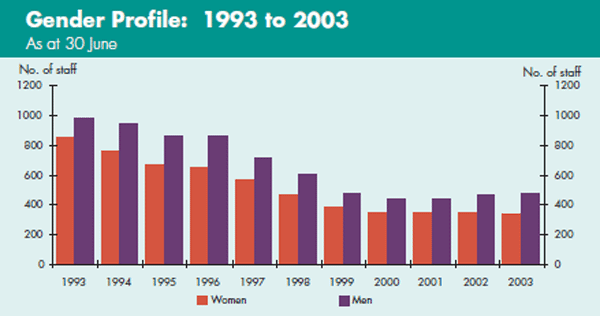
While the percentage of women has declined over the past decade, the percentage of management positions held by women has increased. In 2003, 23% of management positions were held by women, compared to 9% in 1993.
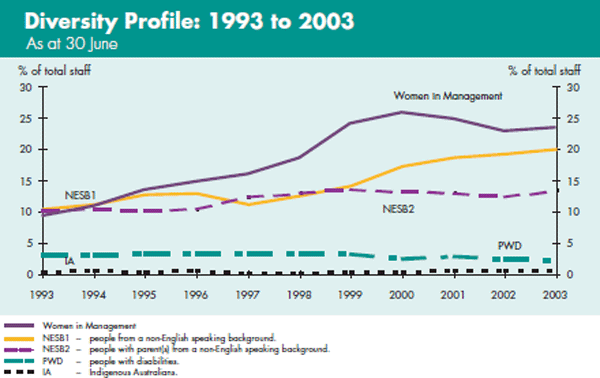
The percentages of Indigenous Australians and people with disabilities employed in the Bank have remained stable for the past 10 years. This is in contrast to the percentage of staff from a non-English speaking background or whose parents are from a non-English speaking background, which has increased.
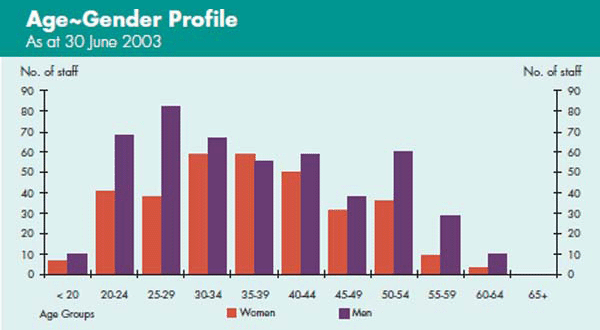
The median age is now 36 years compared to 37 years last reporting period. The percentage of staff aged less than 35 years has remained the same at 46%. Interestingly, over the next five years, potentially 25% of total Bank staff will be eligible for retirement.
There has been little change from last year in the tenure statistics. Approximately 50% of staff have less than 10 years service and 20% have more than 20 years service. The average tenure for this reporting period is 11 years.
3.1 Gender
Occupational Groups & Gender Representation
Gender representation in the various occupational groups continues to be monitored, as well as changes in occupational structure over time. The two main occupational groups are clerical and professional.

The percentage of women in clerical positions continues to decline, with 47% of all women employed in clerical roles in 2003, compared with 58% five years ago. Conversely, the percentage of women in professional positions continues to rise with 39% of all women now employed in professional positions, compared to 30% five years ago.
In 2003, clerical positions made up 28% of all positions compared to 41% in 1999. 68% of these positions were held by women compared to 70% last year. Professional occupations increased by 3% in 2003 with 50% of staff now holding a professional position. This compares to 1999 where 37% of staff were in professional occupations.
Internal Transfers by Functional Group
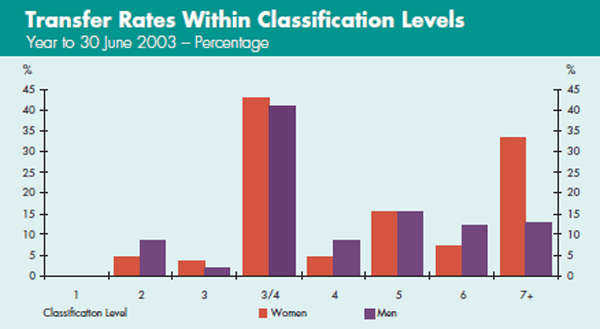
As foreshadowed in last year's report, for this reporting period both rotation and transfer data were analysed to identify any emerging trends. Transfers are notified formally via the Bank's Vacancies & Appointments Circular whereas rotations are temporary movements of staff. The number of transfers recorded for 2002/03 was 71 compared to 56 last year.
This indicated a reversal of a declining trend evident over the past five years; however, the increase was due to the transfer of staff into a new broadbanded graduate classification. The new classification level was introduced during 2001/02 in the policy areas of Economic, Financial Markets and Financial System Groups to acknowledge the overlap in job content, skills and knowledge requirements for these positions.
The percentage of women transferring within the reporting period was down from last year with 7% of women being formally transferred compared to 8% last year. However, the transfer rate for men was up, with 13% of men being formally transferred compared to 7% last year.
The number of rotations had decreased from 70 last year to 55 in 2002/03. For the past five years the numbers of rotations has been steadily declining. While women generally lag behind men in the transfer rate, the percentage of women rotated is higher than that of men. A total of 9% of women were rotated for this reporting period compared to 7% of men.
Graduate Recruitment
In the 2002/03 recruitment drive there was a sharp increase from 227 to 594 in the number of applications received for the Graduate Development Program. This was due to a combination of factors including a revamped RBA marketing campaign; the growing recognition and appeal of the Graduate Development Program; and the general weakness in the market for graduates.
| Year | Women | Men | Total | Ratio |
|---|---|---|---|---|
| 2003 | 8 | 26 | 34 | 24:76 |
| 2002 | 14 | 25 | 39 | 36:64 |
| 2001 | 7 | 26 | 33 | 21:79 |
| 2000 | 14 | 20 | 34 | 41:59 |
| 1999 | 6 | 13 | 19 | 32:68 |
In 2003, the ratio of women to men selected in the graduate intake decreased compared with the last reporting period. Each stage of the recruitment process was analysed to identify possible reasons for this outcome. It was found that more men than women applied for positions with the Bank and this reflected the gender ratio of economic enrolments at universities. Equal percentages of men and women were interviewed but a smaller proportion of women were offered and subsequently accepted positions.
Further analysis will be done to seek to identify any barriers to women in graduate recruitment.
Individual Contracts
| Occupational Group | Women | Men | Total |
|---|---|---|---|
| Managers | 11 | 81 | 92 |
| Professionals | 22 | 53 | 75 |
| Associate Professionals | 10 | 39 | 49 |
| Clerical* | 12 | 6 | 18 |
| As at 30 June 2003 * Includes advanced and intermediate clerical staff. |
|||
In recent years individual employment contracts, which provide a degree of flexibility in remuneration, have been offered to staff following a systematic benchmarking exercise. The change to individual contracts was voluntary and staff who declined the offer of an individual employment contract retained their existing conditions. There has been an increase in the percentage of staff on individual employment contracts compared to last year (57% of staff in 2003 compared to 53% in 2002). The percentage of staff in the clerical group moving to an individual employment contract has doubled with 18% of clerical staff now on individual employment contracts compared to 9% last year. Within that group the percentage of women on contracts has increased from 5% in 2001/02 to 12% in 2002/03.
Pay Equity
An analysis was conducted again this year to identify gender based earning differences. In 2002/03 women earned on average 83% of what men earned. This is consistent with ABS data, which showed that nationally, on average, women's earnings were 84% of men's earnings. Occupational segregation – women being highly represented in clerical positions relative to management positions – and unequal workforce participation are likely to be the major contributing factors.
3.2 Work Life Balance
Child Care Survey
A survey was carried out in late 2002 of 38 Bank staff who have children and who were utilising child care arrangements to provide a snapshot of the type of child care and flexible work arrangements used by staff. The survey results combined with the discussions of a focus group for women who had recently returned to work from parental leave, have assisted in identifying the types of flexible working practices that benefit staff the most.
Carer's Leave
Carer's Leave, which can be taken either on a half or full day basis, was used by about 40% of staff. Those staff on average took 2½ days leave, the same as in previous years.
Part Time Work
During the year, 49 staff worked part time (48 women and 1 man) compared to 36 last year. The figures reflect mostly women on temporary part time work arrangements and do not include staff on fixed term contracts or university students engaged in part time work.
Parental Leave
Women are entitled to 14 weeks' paid parental leave and men are entitled to one week. The chart below provides a breakdown based on gender for staff commencing paid parental leave.
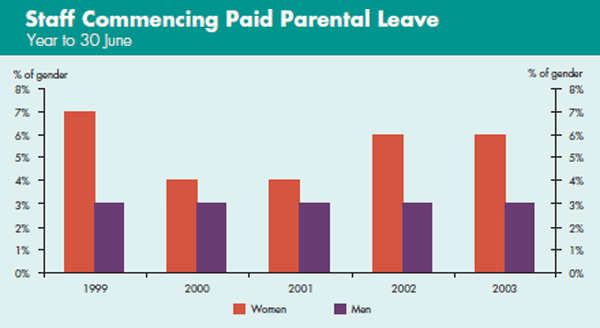
During 2002/03 a total of 33 staff took paid parental leave (18 women and 15 men). This compares to last year where 37 staff took paid parental leave (22 women and 15 men). As part of the 2003–04 Enterprise Bargaining Agreement, the RBA and the main workplace union have agreed to review the RBA's parental leave arrangements in light of any decision by the Australian Industrial Relations Commission (AIRC) on the parental leave test case currently before it.
Of the 24 women completing parental leave during the reporting period, two women resigned and three were retrenched due to the closure of Adelaide Branch. The number of resignations was slightly down on last year when five women resigned. Of the 19 women who returned to work following parental leave, 11 elected to work part time.

During this reporting period a focus group was held with 13 women who had recently returned to work from Parental Leave. The purpose of this focus group was to receive feedback on the types of initiatives these women would like to see included in the Workplace Diversity Plan initiative Welcome Back Program. This Program will provide staff who are returning to work from long-term parental leave with the opportunity to network with each other, and be provided with improved support and training to assist them in their transition back into the workplace.
3.3 Indigenous Australians
Indigenous Australians continue to account for a very small proportion of staff −0.6% in 2003. The designated Indigenous Australian traineeship position was again successfully filled for this reporting period. The 2002 Business Administration trainee was employed by the Bank at the end of the traineeship.
As one way of recognising Indigenous culture, the Bank took the opportunity to highlight and promote to staff NAIDOC Week (National and Aboriginal Islander Day Observance Committee Week) held in July 2003.
During the next reporting period, the feasibility of utilising the Commonwealth Indigenous Cadetship Program will be investigated as an additional way of targeting Indigenous Australians for employment opportunities within the Bank.
3.4 Race-ethnicity
The percentage of staff that identified themselves as NESB1 (staff who are born overseas and whose first language is not English) has remained the same as last year (20%). As reported last year, these employees were heavily represented in the RBA's information technology, accounting and audit departments and shared a common characteristic of being more highly qualified than other staff in these same areas. Consistent with the qualification levels found amongst the NESB1, an analysis of occupational groupings for this group showed that 50% were represented in professional occupations. The graph also shows that 2% of this group were employed in management positions.
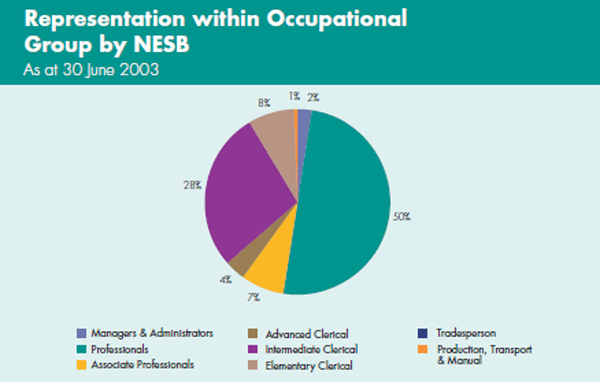
To assist these staff with career progression, a Technical Writing Program was piloted in 2002/03. The objective of this program was to tailor training in the area of written communication to reflect the more technical nature of the documents produced by the information technology, accounting and audit departments and to acknowledge the varying communication styles used by different cultures. Following the pilot, further technical writing courses have been run and the program has been incorporated into the Graduate Development Program for graduates working in those areas. To date a total of 21 staff have attended this two-day course.
On 21 March 2003 the RBA supported and promoted Harmony Day. Staff were provided with information about the meaning of the day via the intranet and staff newsletters. A number of departments also supported the day by encouraging staff to wear something orange (the official colour for Harmony Day). Orange ribbons were also available for staff to wear and the Staff Cafe provided an array of international dishes on the day.

One of the work teams in the RBA's business services area trialled a Cultural Awareness Workshop during the reporting period. The team contained a diverse mix of staff from different cultural and ethnic backgrounds. The objective of the one day workshop was to encourage greater interaction between staff. The program was strongly supported by staff and management and the RBA will look at conducting further workshops in the next reporting period.
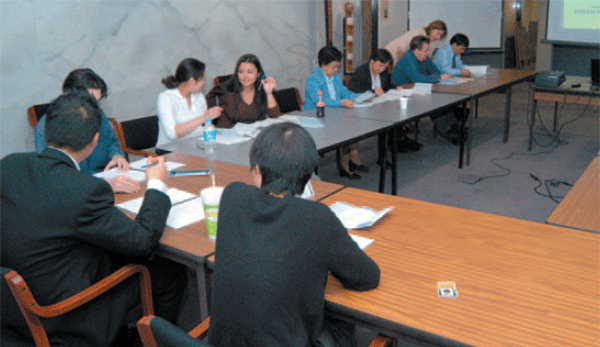
3.5 People with Disabilities
The representation of people with disabilities in the RBA is the same as last year (2%). As noted in previous reports this figure is likely to be conservative as any disability acquired after commencement of employment is not included in the analysis. Furthermore, the definition of disability is subjective and fear or embarrassment may reduce the number willing to identify their disability. To assist in making appropriate adjustments in the workplace for staff with disabilities, in the next reporting period staff will be given the opportunity to update their personal details relating to disability. This will assist in capturing disabilities acquired after commencing employment.
Advice on making adjustments in the workplace to accommodate the needs of staff with disabilities is available to departments. This is provided through the RBA's Occupational Health and Safety Consultants. A Disability Awareness Workshop is run annually for staff and managers to raise the level of understanding and awareness in relation to identifying barriers for people with disabilities and introducing strategies for overcoming the barriers. As at 30 June 2003 a total of 88 staff have attended the Disability Awareness Workshop since it was first held in 1999.
As part of this initiative, training and information sessions were conducted in late 2002 for information technology staff and the Diversity Contact Managers' network on the global standards released by World Wide Web Consortium (W3C) for web content accessibility. Web Content Accessibility is not only a priority for people with a disability but will assist those in the workforce who are going through the physiological changes of aging (eg. diminished vision, loss of hearing, psychomotor impairments). An outcome of a review of the Bank's website found it to be compliant with W3C web accessibility standards. In the next reporting a period a review will be conducted of the Bank's internal website.
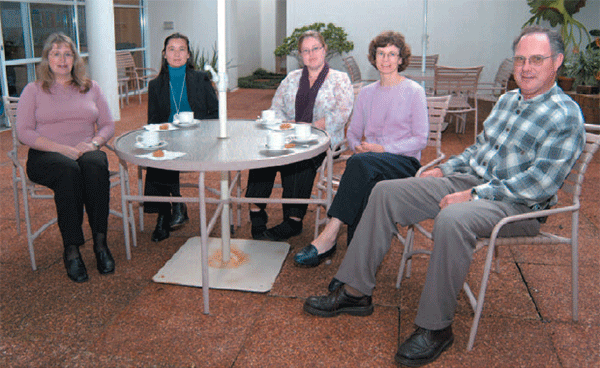
3.6 Summary of Diversity Plan Initiatives
Gender
- Monitor annually the uptake of contracts by women and conduct further analysis on the identified gap between genders and classification levels.
- Review contract remuneration outcomes annually to track any significant variations between women and men in comparable positions. A detailed analysis of occupations by gender representation and remuneration will also be included in the review.
- Review, for effectiveness, specific initiatives associated with the Graduate Development Program designed to enhance the scope for advancement of female graduates into management positions over time.
- Monitor graduate recruitment gender ratio statistics and compare with university enrolment statistics. Identify and remove any barriers for women in the interview stage of the recruitment process.
- Identify opportunities to encourage higher representation of women in management positions.
- Identify where succession plans might not adequately comprehend future retirements.
- Review ASCO codes during the next reporting period to ensure accuracy in classifications and data integrity. Monitor progress of women within professional occupations.
- Review the HR database and update any missing educational qualifications.
Work Life Balance
- Review Intranet site on Work & Family.
- Monitor use of flexible work arrangements annually.
- Review and streamline part time work arrangements during next reporting period.
- Pilot the Welcome Back program for staff returning from parental leave.
- Pilot a Working Parents Forum to provide networking opportunities for new parents.
- Investigate a Welcome Back program for staff returning from extended leave.
- Update workplace profile analysis to review effectiveness of policies, for example, flexible work arrangements.
- Trial work from home arrangements.
- Introduce Personal Leave arrangements.
- Investigate the ‘48/52’ scheme.
Indigenous Australians
- Investigate the feasibility of using the Commonwealth Indigenous Cadetship Program.
- Maintain designated traineeship position with mentoring support.
- Consider conducting Indigenous Cultural Awareness Workshops.
- Highlight opportunities to recognise Indigenous culture, for example NAIDOC Week (July).
Race-ethnicity
- Update the Bank's current equal employment opportunity form to better capture information on race-ethnicity.
- Increase opportunities for NESB1 employees to develop written communication skills.
- Conduct further Cultural Awareness Workshops.
- Highlight opportunities to recognise cultural diversity, for example, Harmony Day (March).
- Conduct training needs analysis for Departments who have a high race-ethnicity mix.
People with Disabilities
- Conduct Disability Awareness Workshop annually.
- Maintain designated traineeship position with mentoring support.
- Provide reasonable adjustment advice to departments employing people with disabilities.
- Finalise and implement the Disability Action Plan for 2003–2005.
- Consider implementing self-service access to the Bank's HR database to enable staff to update their personal information (postponed until 2005).
- Review Intranet site in accordance with W3C web accessibility standards.
- Liaise with Web Manager on W3C web accessibility compliance for Bank's website.